 Lots of email advice may not be based on actual data.mikhail Mokhrushin/Flickr
Lots of email advice may not be based on actual data.mikhail Mokhrushin/Flickr
Writing emails that get responses is an incredibly valuable skill – and what makes an email likely to get a response is hard to determine.
There's a lot of advice about how to write a good email on the web, from general writing advice to full sets of pre-written email templates.
But almost none of that advice shows the data behind it (usually because there isn't any), and a lot of it is contradictory.
So we decided to figure out what factors really matter when you want to get a response to your messages.
If you find this information helps you send better emails, we'd appreciate it if you give Boomerang a try in return. You can send emails at optimal times and get notified if your message doesn't receive a response, so you remember to follow up. You can also include a read receipt, so you know if your message got lost in the pile. Boomerang comes with a basic plan that lets you use it several times a month completely free.
Without further ado, here's the roundup of what really matters when you're sending an email!
Write like a third-grader

Our most surprising finding was that the reading grade level of your emails has a dramatic impact on response rates. Emails written at a third-grade reading level were optimal. They provided a whopping 36% lift over emails written at a college reading level and a 17% higher response rate than emails written even at a high school reading level.
As someone who's been described as a "pedantic rambler," this one hits me right in the fingers. But rather than decry the state of English language education, I'll just try to roll with it and streamline my lexicon simplify my verbiage use shorter words in shorter sentences.
Of course, the context of your email matters a lot. If you're sending an email discussing the finer points of your Ph.D. thesis to the professor who's evaluating you for a postdoctoral fellowship, you probably need every syllable you can get!
On the other hand, if you're emailing football trash talk to an Auburn graduate, don't use words with more than four letters if you want them to understand what you're saying – Roll Tide! If you don't have any reason to adjust the writing level, though, third grade is a good default.
The main parts of your reading grade level score are the number of syllables in your words and the number of words in your sentences. So try simpler words and fewer words per sentence than you normally would. You can check your content's reading grade level in the Word Count tool in most word processors. Or search for "Flesch Kincaid grade level" to find plenty of online tools that can calculate it for you.
Write with emotion
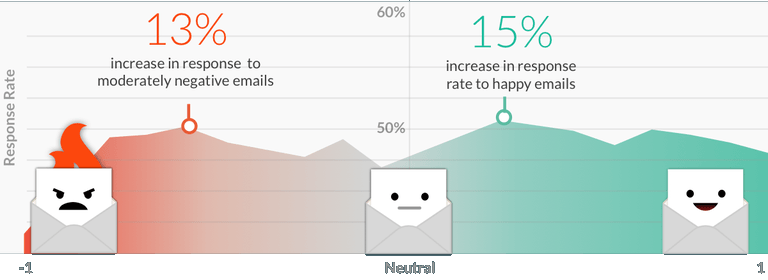
Another significant factor in determining response rates is how positive (words like great, wonderful, delighted, pleased) or negative (words like bad, hate, furious, terrible) the words in the message are. Emails that were slightly to moderately positive OR slightly to moderately negative elicited 10-15% more responses than emails that were completely neutral.
Flattery works, but excessive flattery doesn't. Response rates for positive emails peaked about 15% higher than neutral for emails with a slightly warm tone. After that, response rates declined as the amount of positive language exceeded what would look "normal" in an email.
Sentiment analyzers output a "sentiment score" that ranges from -1 (for piss and vinegar) to 1 (for saccharine), with 0 representing a completely neutral email. To give you some context, here's what some positive emails look like:
• Hey, I was thinking about you earlier. Do you want to get pizza? 0.0, true neutral. A little positivity would boost the response rate.
• Hey, I'd definitely like to get together next week. Do you want to get pizza? 0.35 positive sentiment. Perfect! It's easy to add positive sentiment to an email – this is all it takes.
• Hey, it would be really great to see you and catch up. Do you want to get pizza? Positive 0.55 sentiment. This will also work better than a neutral email, even if not quite as well as the version above.
• Hey! It would be absolutely wonderful to see you! Do you want to get pizza? I'm so excited! Over 0.9 positive sentiment. This email would be about as effective as a neutral email – not bad, really, but not optimal.
We also don't advise penning day-ruining screeds. Poisonously negative emails were the least likely to get a response. However, a moderately negative email is your best bet for a complaint, working 13% better than similar content expressed in a neutral tone.
• I had a less than optimal experience in your store today. The clerk wasn't very nice. Could you please consider my feedback? Negative 0.1 sentiment. Almost neutral – not negative enough.
• I had an awful experience at your store today. The clerk was very rude. Please do something to make it right. Negative 0.35 sentiment. A perfectly moderated amount of negativity.
• I had the worst experience at your store earlier today. The clerk was rude and patronizing. I will never come back. Negative 0.55 sentiment. Still OK, but a little too negative to be optimal.
• Your store experience sucks. Your clerk is a douchebag. Piss off and I hope you die in agony. Over 0.9 negative sentiment. Way too negative, significantly reduced response rates.
Testing the sentiment of your emails takes more work than calculating the reading grade level. Most word processors don't support sentiment analysis yet, and online tools report wildly varying results for the same content.
The reason is that most sentiment analyzers work by using machine learning techniques to train algorithms which words are positive or negative, based on whatever training data their authors could track down.
The training data matters a lot – one common source is movie reviews, since they come with a numerical score that can be used as a proxy for how positive the review is likely to be. This data is all noisy, and because machine learning generates incredibly complicated algorithms, it's hard to calibrate after the fact.
As a result, while we trust the outputs enough for aggregate data with a large sample size, your best bet for evaluating the sentiment of an individual email is still your own judgment.
Write short (but not too short!) emails
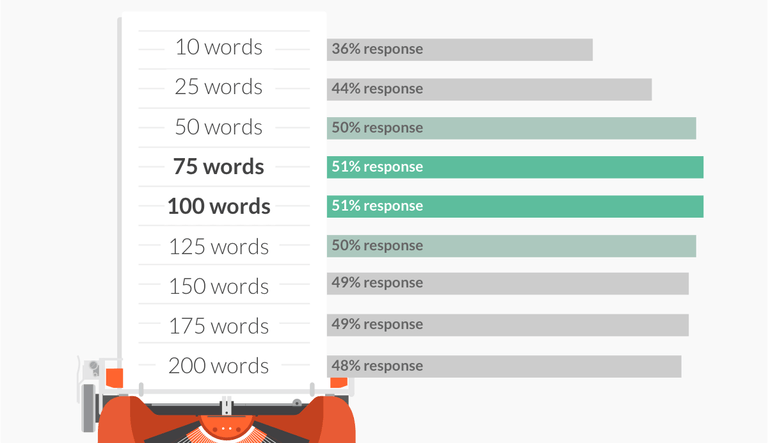
The sweet spot for email length is between 50-125 words, all of which yielded response rates above 50%.
Response rates declined slowly from 50% for 125-word messages to about 44% for 500-word messages. After that, it stayed flat until about 2,000 words, then declined precipitously. So while the optimal length for an email is under 125 words, you shouldn't worry too much if you need a few extra.
Go ahead and include everything you need for the message to be complete, but don't add too much extra. Above 2,500 words, response rates tumbled to below 35%, so if you need to send War and Peace, you should consider sending it as an attachment!
On the other hand, emails under 50 words showed a much steeper decline in response rates. A 25-word email works about as well as a 2000-word one, with only a 44% chance of getting a response.
While average emails from Jeb and Hillary clock in at 10 and 9 words respectively, unless you're running for President, sending emails that short mean you'll sacrifice about 30% of your responses. Messages with subjects only performed worst of all – only 11% of messages that contained nothing in the body received a response.
A word count tool like the one included in most word processors can show you exactly how many words are in your email, but a quick glance will get you in the vicinity. A 50-word email looks like two short paragraphs. A 125-word email is roughly two normal paragraphs plus a short one.
Use short (very short) subject lines
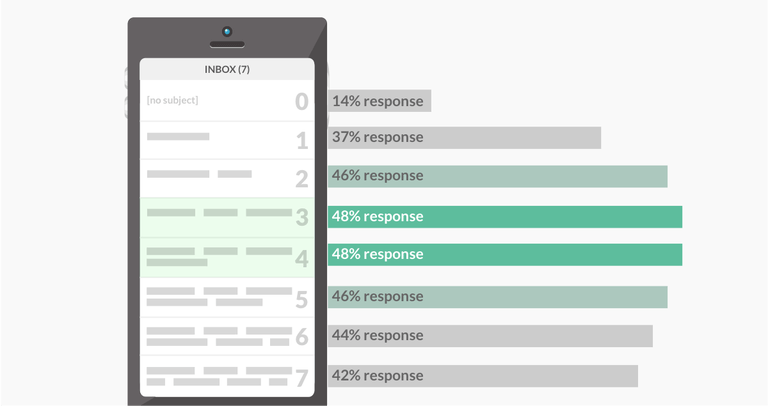
Email marketing veterans know that testing subject lines is a critical step in designing an email campaign that will have a high open rate. Likewise, the length of your subject line impacts response rates, and the optimal length is shorter than we expected. Subject lines with only 3-4 words (excluding email conventions like Re: and Fwd:) received the most responses.
Once again, though, the response rates dropped slowly as more words were added. So if an extra subject line word will add a lot of clarity, go ahead and include it. Including some sort of subject line is critical: only 14% of messages without any subject line at all received a response!
Questions
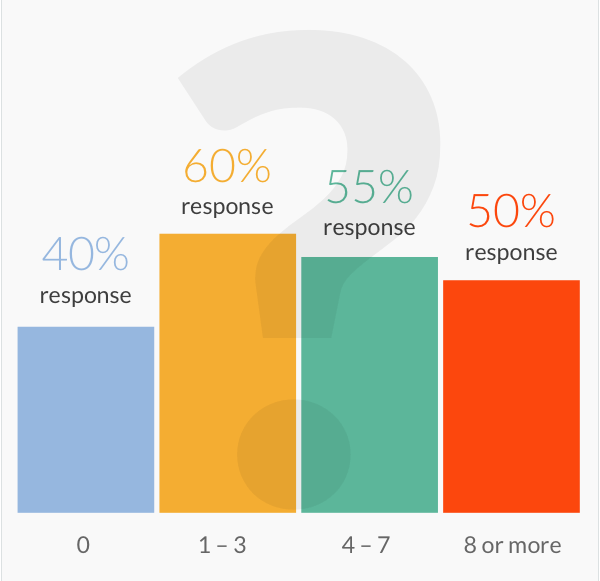
The number of questions you ask in an email has a sweet spot, just like the number of words you write. We found that emails that asked 1-3 questions are 50% more likely to get a response than emails asking no questions.
But a bombardment of questions won't help you either – an email with 3 questions is 20% more likely to get a response than an email with 8 or more!
Subjectivity
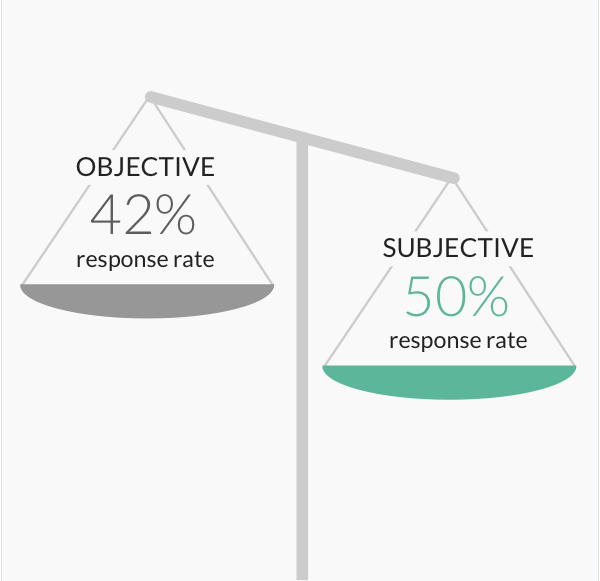
If your natural writing style has a "just the facts, ma'am" bias, you should consider including more opinions and more subjectivity into your messages!
The more opinionated the content of the email, the higher the response rate climbed. One caveat – we have no idea if those subjective emails generated positive responses or declarations of war, so caveat writer!
Before we wrap up, a couple years ago we put together an infographic with a bunch more information about writing effective emails, including which words to use and which words to avoid in your subject lines.
One of the takeaways from that study was that sending emails early in the mornings and during lunch yields a higher response rate than sending emails mid-morning or in the afternoon. Using Boomerang, you can send your messages at optimal times, regardless of when you're writing them. And even the most-optimized emails won't get a 100% response rate. We'll be happy to let you know if you don't get a timely reply to an important message, just as we did for the 40 million emails that inspired this post.
Thanks for reading! If you found this post helpful, please share it! Finally, here's a digestible summary of everything we learned. Have a great Year of the Monkey, filled with brilliantly-written emails!
Here's a summary of our best practices for making your emails more likely to get a response.
1. Use shorter sentences with simpler words. A 3rd grade reading level works best.
2. Include 1-3 questions in your email.
3. Make sure you include a subject line! Aim for 3-4 words.
4. Use a slightly positive or slightly negative tone. Both outperform a completely neutral tone.
5. Take a stand! Opinionated messages see higher response rates than objective ones.
6. Write enough, but not too much. Try to keep messages between 50-125 words.
Read the original article on Boomerang. Copyright 2017. Follow Boomerang on Twitter.




